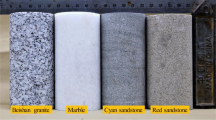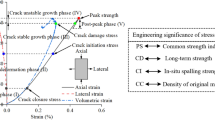Abstract
The crack initiation stress (CI), a threshold stress at which brittle rock starts to become damaged during compression, has been widely studied. It can be used to estimate the spalling strength of tunnels in brittle rock masses. Many methods based on stress–strain curves and acoustic emission data have been proposed to identify the CI, and these methods have good statistical consistency. In the present study, the influence of varying the Poisson's ratio on the value of the CI is analyzed using the crack volumetric strain (CVS) method, and the physical meaning of the lateral strain response (LSR) method is explained. Based on the LSR method, a more stable lateral strain interval response (LSIR) method is proposed to determine the CI. We analyzed the CI of granite samples from two deep boreholes in the Beishan area, the site of China’s underground research laboratory (URL). The results show that the mean CI values determined by our proposed method are in good agreement with the results from the LSR method. The standard deviation and correlation analysis show that the CI values obtained by the proposed method have a smaller dispersion and a higher independence than those from the LSR method.





















Similar content being viewed by others
Abbreviations
- \(\sigma_{1}\) :
-
Maximum principal stress
- \(\sigma_{3}\) :
-
Minimum principal stress
- E :
-
Elasticity modulus
- \(v\) :
-
Poisson's ratio
- ΔV :
-
Olume increment
- V :
-
Volume of rock
- (ΔV/V)el :
-
Elastic volumetric strain
- (ΔV/V)cr :
-
Crack volumetric strain
- ΔV/V :
-
Total volumetric strain
- \(\varepsilon_{1}\) :
-
Axial strain
- \(\varepsilon_{3}\) :
-
Lateral strain
- \({\Delta }\varepsilon_{1}\) :
-
Axial strain increment
- \({\Delta }\varepsilon_{3}\) :
-
Lateral strain increment
- \(E_{3}\) :
-
Lateral stiffness of elastic stage
- \(\varepsilon_{{{\text{e}}1}}\) :
-
Axial elastic strain
- \(\varepsilon_{{{\text{e}}3}}\) :
-
Lateral elastic strain
- \(\varepsilon_{3}^{{\text{c}}}\) :
-
Relative compression strain
- \(\varepsilon_{3}^{{\text{d}}}\) :
-
Lateral strain corresponding to the crack damage stress
- \(\sigma_{{{\text{cd}}}}\) :
-
Crack damage stress
- CC:
-
Crack closure stress
- CI:
-
Crack initiation stress
- CD:
-
Crack damage stress
- CVS:
-
Crack volumetric strain
- LSR:
-
Lateral strain response
- RCSR:
-
Relative compression strain response
- CAEH:
-
Cumulative AE hit
- UCS:
-
Uniaxial compressive strength
- URL:
-
Underground research laboratory
References
Amann F, Button ED, Evans KF, Gischig VS, Blümel M (2011) Experimental study of the brittle behavior of clay shale in rapid unconfined compression. Rock Mech Rock Eng 44(4):415–430. https://doi.org/10.1007/s00603-011-0156-3
Bieniawski ZT (1967) Mechanism of brittle fracture of rock: part I—theory of the fracture process. Int J Rock Mech Min Sci Geomech Abstr 4(4):395–406. https://doi.org/10.1016/0148-9062(67)90032-0
Brace WF, Paulding BW Jr, Scholz CH (1966) Dilatancy in the fracture of crystalline rocks. J Geophys Res 71(16):3939–3953. https://doi.org/10.1029/JZ071i016p03939
Cai M (2010) Practical estimates of tensile strength and Hoek-Brown strength parameter m i of brittle rocks. Rock Mech Rock Eng 43(2):167–184. https://doi.org/10.1007/s00603-009-0053-1
Cai M, Kaiser PK, Tasaka Y, Maejima T, Morioka H et al (2004) Generalized crack initiation and crack damage stress thresholds of brittle rock masses near underground excavations. Int J Rock Mech Min 41(5):833–847. https://doi.org/10.1016/j.ijrmms.2004.02.001
Chen SW, Yang CH, Wang GB, Wei X (2016) Experimental study on the determination method of σcc, σci and σcd for granite under different confining pressures. J Northeastern Univ 37(12):1789–1793. https://doi.org/10.3969/j.issn.1005-3026.2016.12.025
Damjanac B, Fairhurst C (2010) Evidence for a long-term strength threshold in crystalline rock. Rock Mech Rock Eng 43(5):513–531. https://doi.org/10.1007/s00603-010-0090-9
Diederichs MS (2007) The 2003 Canadian geotechnical colloquium: mechanistic interpretation and practical application of damage and spalling prediction criteria for deep tunnelling. Can Geotech J 44(9):1082–1116. https://doi.org/10.1139/t07-033
Diederichs MS, Kaiser PK, Eberhardt E (2004) Damage initiation and propagation in hard rock during tunnelling and the influence of near-face stress rotation. Int J of Rock Mech Min 41(5):785–812. https://doi.org/10.1016/j.ijrmms.2004.02.003
Eberhardt E, Stead D, Stimpson B, Read RS (1998) Identifying crack initiation and propagation thresholds in brittle rock. Can Geotech J 35(2):222–233. https://doi.org/10.1139/cgj-35-2-222
Kelsall PC, Case JB, Chabannes CR (1984) Evaluation of excavation-induced changes in rock permeability. Int J Rock Mech Min Sci Geomech Abstr 21(3):123–135. https://doi.org/10.1016/0148-9062(84)91530-4
Lajtai EZ (1974) Brittle fracture in compression. Int J Fracture 10(4):525–536. https://doi.org/10.1007/BF00155255
Li D, Li CC, Li X (2011) Influence of sample height-to-width ratios on failure mode for rectangular prism samples of hard rock loaded in uniaxial compression. Rock Mech Rock Eng 44(3):253–267. https://doi.org/10.1007/s00603-010-0127-0
Lockner D (1993) The role of acoustic emission in the study of rock fracture. Int J Rock Mech Min Sci Geomech Abstr 30(7):883–899. https://doi.org/10.1016/0148-9062(93)90041-B
Martin CD (1993) The strength of massive Lac du Bonnet granite around underground openings. PhD Thesis. Winnipeg. Manitoba. University of Manitoba
Martin CD, Chandler NA (1994) The progressive fracture of Lac du Bonnet granite. Int J Rock Mech Min Sci Geomech Abstr 31(6):643–659. https://doi.org/10.1016/0148-9062(94)90005-1
Martin CD, Kaiser PK, McCreath DR (1999) Hoek-Brown parameters for predicting the depth of brittle failure around tunnels. Can Geotech J 36(1):136–151. https://doi.org/10.1139/cgj-36-1-136
Nicksiar M, Martin CD (2012) Evaluation of methods for determining crack initiation in compression tests on low-porosity rocks. Rock Mech Rock Eng 45(4):607–617. https://doi.org/10.1007/s00603-012-0221-6
Nicksiar M, Martin CD (2013) Crack initiation stress in low porosity crystalline and sedimentary rocks. Eng Geol 154:64–76. https://doi.org/10.1016/j.enggeo.2012.12.007
Peng J, Rong G, Jiang MY (2018) Variability of crack initiation and crack damage for various rock types. Arab J Geosci 11(11):265. https://doi.org/10.1007/s12517-018-3618-z
Wang J, Chen L, Su R, Zhao XG (2018) The Beishan underground research laboratory for geological disposal of high-level radioactive waste in China: planning, site selection, site characterization and in situ tests. J Rock Mech Geotech Eng 10(3):411–435. https://doi.org/10.1016/j.jrmge.2018.03.002
Wen T, Tang HM, Ma JW, Wang YK (2018) Evaluation of methods for determining crack initiation stress under compression. Eng Geol 235:81–97. https://doi.org/10.1016/j.enggeo.2018.01.018
Zhang XP, Wong LNY (2013) Crack initiation, propagation and coalescence in rock-like material containing two flaws: a numerical study based on bonded-particle model approach. Rock Mech Rock Eng 46:1001–1021. https://doi.org/10.1007/s00603-012-0323-1
Zhang XP, Wong LNY, Wang SJ, Han GY (2011) Engineering properties of quartz mica schist. Eng Geol 121(3–4):135–149. https://doi.org/10.1016/j.enggeo.2011.04.020
Zhang XP, Zhang Q, Wu SC (2017) Acoustic emission characteristics of the rock-like material containing a single flaw under different compressive loading rates. Comput Geotech 83:83–97. https://doi.org/10.1016/j.compgeo.2016.11.003
Zhang XP, Lv GG, Liu QS et al (2021) Identifying accurate crack initiation and propagation thresholds in siliceous siltstone and limestone. Rock Mech Rock Eng 54:973–980. https://doi.org/10.1007/s00603-020-02277-y
Zhao XG, Cai M, Wang J, Ma LK (2013) Damage stress and acoustic emission characteristics of the Beishan granite. Int J Rock Mech Min 64(12):258–269. https://doi.org/10.1016/j.ijrmms.2013.09.003
Zhao XG, Cai M, Wang J, Li PF, Ma LK (2015) Objective determination of crack initiation stress of brittle rocks under compression using AE measurement. Rock Mech Rock Eng 48(6):2473–2484. https://doi.org/10.1007/s00603-014-0703-9
Acknowledgements
This work was supported by the Key Projects of the National Natural Science Foundation of China [Grant Number 51234004]; the Project of Decommissioning of Nuclear Facilities and Radioactive Waste Management; and the National Key Research and Development Program of China (NO. 2017YFC0804601, 2018YFC0808403). The authors are sincerely grateful to Professor Jaak J Daemen, Mackay School of Earth Sciences and Engineering, University of Nevada, for his thoughtful proofreading of this paper.
Author information
Authors and Affiliations
Corresponding authors
Ethics declarations
Conflict of Interest
The authors know that there is no conflict of interest concerning the publication of this technical note.
Additional information
Publisher's Note
Springer Nature remains neutral with regard to jurisdictional claims in published maps and institutional affiliations.
Rights and permissions
About this article
Cite this article
Tang, M., Wang, G., Chen, S. et al. An Objective Crack Initiation Stress Identification Method for Brittle Rock Under Compression Using a Reference Line. Rock Mech Rock Eng 54, 4283–4298 (2021). https://doi.org/10.1007/s00603-021-02479-y
Received:
Accepted:
Published:
Issue Date:
DOI: https://doi.org/10.1007/s00603-021-02479-y




